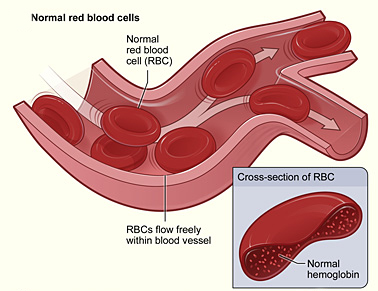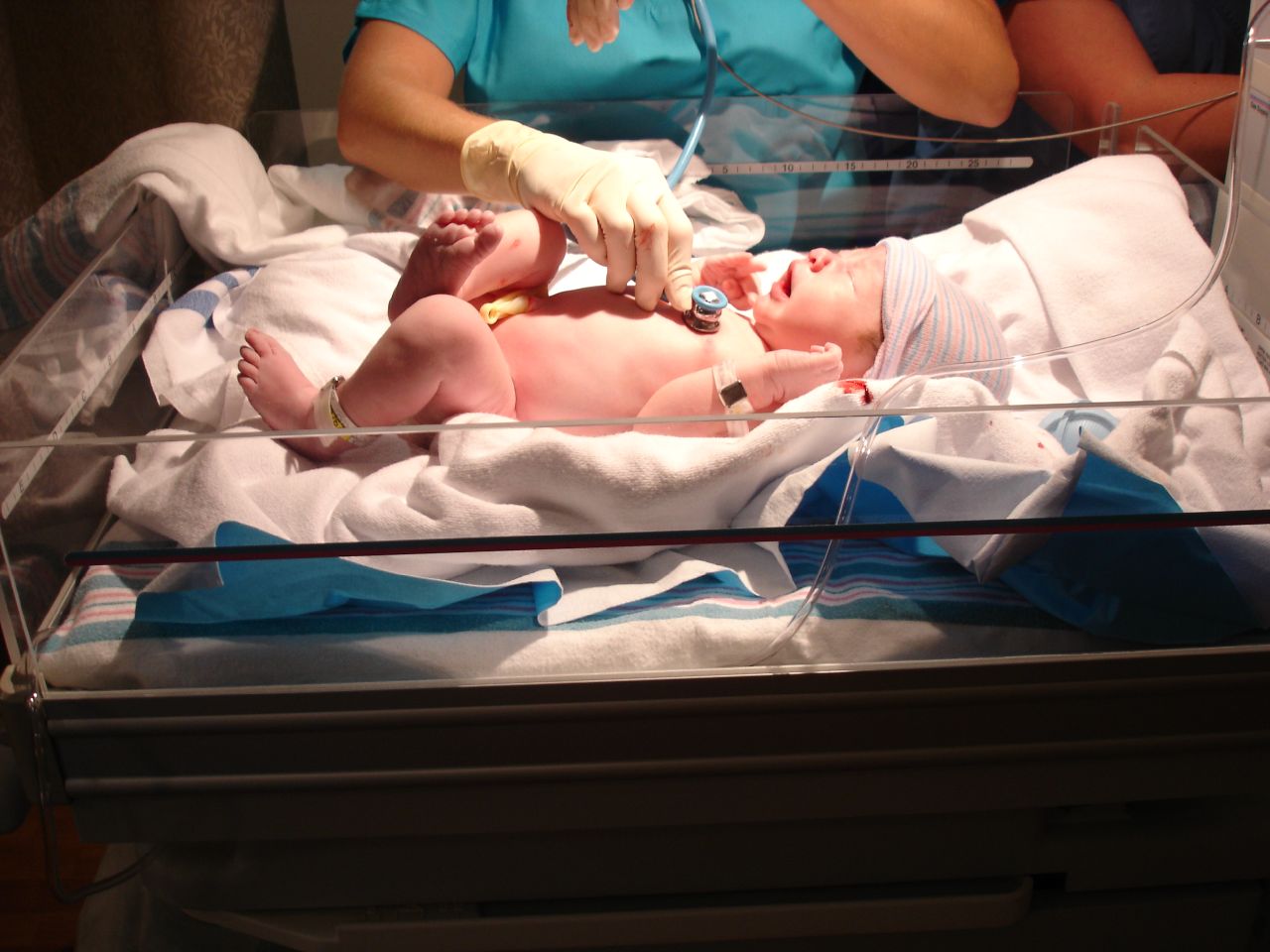|
Anemia Of Prematurity
Anemia of prematurity (AOP) refers to a form of anemia affecting preterm infants with decreased hematocrit. AOP is a normochromic, normocytic hypoproliferative anemia. The primary mechanism of AOP is a decrease in erythropoietin (EPO), a red blood cell growth factor. Mechanism Preterm infants are often anemic and typically experience heavy blood losses from frequent laboratory testing in the first few weeks of life. Although their anemia is multifactorial, repeated blood sampling and reduced erythropoiesis with extremely low serum levels of erythropoietin (EPO) are major causative factors. Blood sampling done for laboratory testing can easily remove enough blood to produce anemia. Obladen, Sachsenweger and Stahnke (1987) studied 60 very low birth weight infants during the first 28 days of life. Infants were divided into 3 groups, group 1 (no ventilator support, 24 ml/kg blood loss), group 2(minor ventilated support, 60 ml/kg blood loss), and group 3(ventilated support for respirat ... [...More Info...] [...Related Items...] OR: [Wikipedia] [Google] [Baidu] |
Anemia
Anemia (also spelt anaemia in British English) is a blood disorder in which the blood has a reduced ability to carry oxygen. This can be due to a lower than normal number of red blood cells, a reduction in the amount of hemoglobin available for oxygen transport, or abnormalities in hemoglobin that impair its function. The name is derived . When anemia comes on slowly, the symptoms are often vague, such as Fatigue, tiredness, weakness, shortness of breath, headaches, and a Exercise intolerance, reduced ability to exercise. When anemia is acute, symptoms may include confusion, lightheadedness, feeling like one is going to pass out, Syncope (medicine), loss of consciousness, and polydipsia, increased thirst. Anemia must be significant before a person becomes noticeably Pallor, pale. Additional symptoms may occur depending on the underlying cause. Anemia can be temporary or long term and can range from mild to severe. Anemia can be caused by blood loss, decreased red blood cel ... [...More Info...] [...Related Items...] OR: [Wikipedia] [Google] [Baidu] |
Hematocrit
The hematocrit () (Ht or HCT), also known by several other names, is the volume percentage (vol%) of red blood cells (RBCs) in blood, measured as part of a blood test. The measurement depends on the number and size of red blood cells. It is normally 40.7–50.3% for males and 36.1–44.3% for females. It is a part of a person's complete blood count results, along with hemoglobin concentration, white blood cell count and platelet count. Because the purpose of red blood cells is to transfer oxygen from the lungs to body tissues, a blood sample's hematocrit—the red blood cell volume percentage—can become a point of reference of its capability of delivering oxygen. Hematocrit levels that are too high or too low can indicate a blood disorder, dehydration, or other medical conditions. An abnormally low hematocrit may suggest anemia, a decrease in the total amount of red blood cells, while an abnormally high hematocrit is called polycythemia. Both are potentially life-threatening d ... [...More Info...] [...Related Items...] OR: [Wikipedia] [Google] [Baidu] |
Erythropoietin
Erythropoietin (; EPO), also known as erythropoetin, haematopoietin, or haemopoietin, is a glycoprotein cytokine secreted mainly by the kidneys in response to cellular hypoxia; it stimulates red blood cell production ( erythropoiesis) in the bone marrow. Low levels of EPO (around 10 mU/mL) are constantly secreted in sufficient quantities to compensate for normal red blood cell turnover. Common causes of cellular hypoxia resulting in elevated levels of EPO (up to 10 000 mU/mL) include any anemia, and hypoxemia due to chronic lung disease. Erythropoietin is largely synthesized by fibroblast-like type-1 interstitial cells, located primarily in the deep renal cortex in close association with the peritubular capillaries and proximal convoluted tubule; it is also produced in perisinusoidal cells in the liver. Liver production predominates in the fetal and perinatal period; renal production predominates in adulthood. It is homologous with thrombopoietin. ... [...More Info...] [...Related Items...] OR: [Wikipedia] [Google] [Baidu] |
Phlebotomy
Phlebotomy is the process of making a puncture in a vein, usually in the arm, with a cannula for the purpose of drawing blood. The procedure itself is known as a venipuncture, which is also used for intravenous therapy. A person who performs a phlebotomy is called a phlebotomist, although most doctors, nurses, and other technicians can also carry out a phlebotomy. In contrast, phlebectomy is the removal of a vein. Phlebotomies that are carried out in the treatment of some blood disorders are known as '' therapeutic phlebotomies''. The average volume of whole blood drawn in a therapeutic phlebotomy to an adult is 1 unit (450–500 ml) weekly to once every several months, as needed. Etymology From ( – 'blood vessel, vein' + 'cutting'), via (modern French ). Phlebotomies Phlebotomies are carried out by phlebotomists – people trained to draw blood mostly from veins for clinical or medical testing, transfusions, donations, or research. Blood is collected primarily by per ... [...More Info...] [...Related Items...] OR: [Wikipedia] [Google] [Baidu] |
List Of Circulatory System Conditions
:''This is an incomplete list, which may never be able to satisfy certain standards for completion.'' There are many conditions of or affecting the human circulatory system — the biological system that includes the pumping and channeling of blood to and from the body and lungs with heart, blood and blood vessels. Cardiovascular * Angina * Acute coronary syndrome * Anomic aphasia * Aortic dissection * Aortic regurgitation * Aortic stenosis * Apoplexy * Apraxia * Arrhythmias * Asymmetric septal hypertrophy (ASH) * Atherosclerosis * Atrial flutter * Atrial septal defect * Atrioventricular canal defect * Atrioventricular septal defect * Avascular necrosis Cardiac electrophysiology ''See also :Cardiac electrophysiology'' * AV nodal reentrant tachycardia (Atrioventricular nodal reentrant tachycardia) * Accelerated idioventricular rhythm * Andersen–Tawil syndrome (Andersen cardiodysrhythmic periodic paralysis, Andersen syndrome, Long QT syndrome 7; Periodic paralysis, potassi ... [...More Info...] [...Related Items...] OR: [Wikipedia] [Google] [Baidu] |
List Of Hematologic Conditions
:''This is an incomplete list, which may never be able to satisfy certain standards for completion.'' There are many conditions of or affecting the human hematologic system—the biological system that includes plasma, platelets, leukocytes, and erythrocytes, the major components of blood and the bone marrow. Anemias An anemia is a decrease in number of red blood cells (RBCs) or less than the normal quantity of hemoglobin in the blood.MedicineNet.com Definition of Anemia Last Editorial Review: 12/9/2000 Retrieved March 27, 2011''Merriam-Webster Dictionary'' anemia Retrieved on March 27, 2011 However, it can include decreas ... [...More Info...] [...Related Items...] OR: [Wikipedia] [Google] [Baidu] |
Anemias
Anemia (also spelt anaemia in British English) is a blood disorder in which the blood has a reduced ability to carry oxygen. This can be due to a lower than normal number of red blood cells, a reduction in the amount of hemoglobin available for oxygen transport, or abnormalities in hemoglobin that impair its function. The name is derived . When anemia comes on slowly, the symptoms are often vague, such as Fatigue, tiredness, weakness, shortness of breath, headaches, and a Exercise intolerance, reduced ability to exercise. When anemia is acute, symptoms may include confusion, lightheadedness, feeling like one is going to pass out, Syncope (medicine), loss of consciousness, and polydipsia, increased thirst. Anemia must be significant before a person becomes noticeably Pallor, pale. Additional symptoms may occur depending on the underlying cause. Anemia can be temporary or long term and can range from mild to severe. Anemia can be caused by blood loss, decreased red blood cel ... [...More Info...] [...Related Items...] OR: [Wikipedia] [Google] [Baidu] |
Neonatology
Neonatology is a subspecialty of pediatrics that consists of the medical care of newborn infants, especially the ill or premature newborn. It is a hospital-based specialty and is usually practised in neonatal intensive care units (NICUs). The principal patients of neonatologists are newborn infants who are ill or require special medical care due to prematurity, low birth weight, intrauterine growth restriction, congenital malformations ( birth defects), sepsis, pulmonary hypoplasia, or birth asphyxia. Historical developments Though high infant mortality rates were recognized by the medical community at least as early as the 1860s, advances in modern neonatal intensive care have led to a significant decline in infant mortality in the modern era. This has been achieved through a combination of technological advances, enhanced understanding of newborn physiology, improved sanitation practices, and development of specialized units for neonatal intensive care. Around the mid ... [...More Info...] [...Related Items...] OR: [Wikipedia] [Google] [Baidu] |



